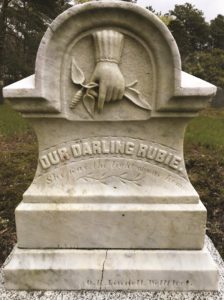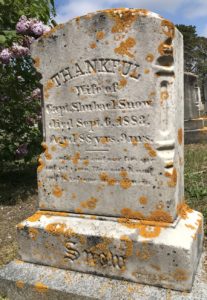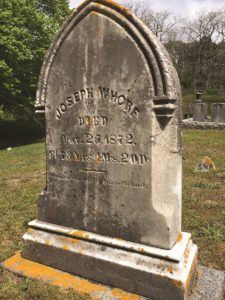Even on an overcast day in Truro’s Pine Grove Cemetery, a small marble headstone glows with an other-worldly presence. A beautifully rendered hand clutching a simple flower points downward to the inscription: “OUR DARLING RUBIE. She was the light of our home.”

While some might interpret the direction the hand is pointing as symbolizing eternal damnation, in fact it symbolizes the hand of fate reaching down and taking someone too soon or unexpectedly. Rubie Rich, the daughter of Sylvanus and Priscilla Rich, died in 1872 at age seven. She succumbed, after an illness of three weeks, to tonsilitis and the croup.
Visitors enchanted by Rubie’s headstone will be forgiven for overlooking the signature on its base of its maker, O.H. Linnell of Wellfleet. Though most headstone carvers — employing skilled masonry, artistic design, and the historical customs of the day — were anonymous, their stones unsigned, some including Linnell chose to sign or initial their work.
Oliver Herbert Linnell (1849-1932) was one of 10 children born in Orleans to Oliver Nickerson Linnell and Adeline Gibbs Rogers. The Linnell name is infrequently found beyond Orleans, but in the Orleans Cemetery more than 150 graves bear it.

The first of the family to arrive on the Outer Cape was Jonathan Linnell (1668-1726), the son of David, who went to Eastham (then known as Nauset and not yet separated from Orleans) from Barnstable in the mid-1690s. Five generations later, Oliver Nickerson Linnell was born in 1816. After following the sea for more than a decade, O.N. Linnell established himself as a marble worker, one of a dozen or so resident carvers in neighboring towns on Cape Cod during the mid-19th century.
In time, he was joined by his son, who had also gone to sea for several years. By the early 1870s, Oliver Herbert Linnell had established his own marble carving business, to which he had added an undertaking business by 1880. Civic-minded, O.H. Linnell served Wellfleet for more than three decades as selectman, sealer of weights and measures, and constable. He also served as deputy sheriff of Barnstable County and was a longtime and prominent member of the Adams Masonic Lodge.
He married Augusta Tilden Knowles, who predeceased him. The couple had two daughters, one of whom, Ada Afton, died sadly at 17 from tuberculosis, then known as phthisis. Linnell is buried with his wife and daughter in Wellfleet’s Oakdale Cemetery, adjacent to Pleasant Hill Cemetery on Gross Hill Road. Oakdale Cemetery, originally established as a Congregational cemetery when Duck Creek Cemetery ran out of burial space, was conveyed to the town of Wellfleet in 1977 and is now a nonsectarian burial ground. Linnell’s bold black granite monument stands in stark contrast to the delicate and elegant white marbles he fashioned for others.
Like most carvers, Linnell worked locally, and his marbles appear to be concentrated in Truro. The sharp-eyed and curious cemetery explorer soon becomes adept at spotting examples of his work, thus adding an aspect of treasure hunting to a cemetery visit. A few Linnells have been inventoried, but many more await discovery.

Without a carver’s signature, it is challenging (if not impossible) to positively identify the maker. Many were inspired in their decorative traditions by other carvers or learned from them as apprentices and so adopted their style. One wonders why Linnell routinely chose to sign his memorials, marking ownership, when so many others preferred anonymity. Did he consider himself an artist (they, by long-established custom, did sign their work) rather than one of the “amateur” general tradesmen who had traditionally carved headstones? Does the addition of his name on the stone detract from honoring a departed loved one, or was his signature a personal expression of his relationship to the neighbors for whom he worked? The benefit for posterity in having his work signed is that we can assess his oeuvre and craftsmanship.
Marble headstones became fashionable in America during the Victorian era after the stone was first quarried in Vermont in the 1790s. Since ancient times, marble has been the preferred stone for carving. Moderately hard, it holds very fine detail but is susceptible to environmental pollutants and does not hold up especially well outdoors. Thus, in time, the more durable granite became the preferred material for headstones.
Given the Cape’s exposure and vulnerability to the elements, Linnell’s marbles are in remarkably good condition, though many other marbles in the same cemeteries have not fared as well, their lettering having eroded and been made illegible, and the stone itself pitted, cracked, and broken. We may be thankful that those stones in a more fragile and discolored condition are beginning to receive the attention they deserve from cemetery commissioners and volunteers.



